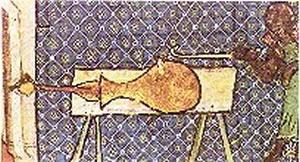| |
| The precise
date and place the cannon was first introduced to the battlefield is anyone's
guess. In 1326 the historian Walter de Milemete wrote a document for King
Edward III in which he added the drawing shown on the right. It shows a
knight firing a vase-shaped cannon. The projectile is shown to be an arrow
which lends support to the theory that early cannons were simply barrel
of filled with gunpowder used to fire rocks and arrows. |
|
| Even
as late as 1844 the mortality rate for gunners was one of the highest
in the army. Guns (cannons) often split open, backfired or simply exploded.
With all its problems the cannon was one of the most fearsome weapons
of its time and for a short time considered the ultimate weapon. Just
the mere suggestion of the use of the cannon was enough to act as a deterrent.
It had a major impact on the battlefield and influenced the political
makeup of nations. |
| The
earliest cannons were very unreliable often made of wood and later strengthened
with metal bands. Military engineers soon realised, that if a cannon was
to last a military campaign, wood needed to be replaced by metal. Metal
for cannon manufacture,was needed in large quantities early in the sixteenth
century . Throughout Europe the preferred metal was iron but in England
the armies of Henry VIII preferred bronze. In both cases, large amounts
of metal had to be mined and smelted. Europe mined iron oxide deposits
while England mined copper and tin. This had an immense impact on the
onset of the Industrial Revolution. |
Mathematicians
soon came into the picture in the development of the cannon. Although
gunpowder was used to propel the projectile to its target the amount used
was critical. Too much gunpowder and the chamber would exceed its pressure
limit resulting in the explosion of the cannon, while too little resulted
in an insufficient force to propel the cannon ball. A set of formulae
were soon calculated by mathematicians that specified exactly the amount
of gunpowder needed to fire the projectile a given distance.
The French implemented an entire
research and development program that resulted in the weapons system they
christened the "Cannon". This new weapons system had to have
new science and technologies such as, mathematical formulae for projectile
motion, smelting and alloying techniques to increase the hardness of the
metal barrel and chamber and granulated gunpowder which released a greater
force when ignited. |
| But now the French needed a
mobile weapon, one that can deploy simultaneously with infantry. It was
decided that the cannon was to be mobile, but the physics principles of
Sir Isaac Newton had not yet been discovered.
One major problem lay ahead, that of recoil, best explained by the law that
" For every action there is an equal and opposite reaction".
The solution was to place the cannon on wheels. This allowed the cannon
to recoil backwards and then be pushed back into position for the next shot. |
|
| One
last innovation was to make the cannon a revolutionary weapons system
rendering castles obsolete and promised total supremacy on the battlefield.
A screw type mechanism, called a trunnion, enabled the gun barrel
to be elevated to achieve different ranges and trajectories.
With this technology at his command, Charles VIII confidently crossed
the border from France into Italy in 1494. But a very simple innovation
to castle defence frustrated the French. It was simple dirt. The italians
placed mounts of dirt against the castle walls which absorbed the force
of the cannonballs and rendered them useless. |
|

